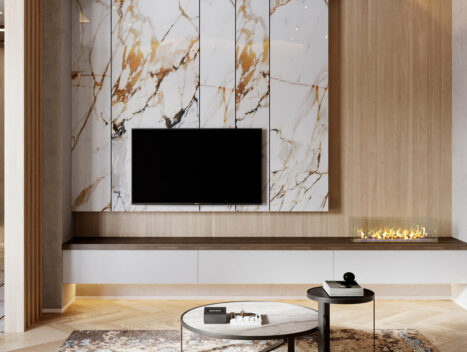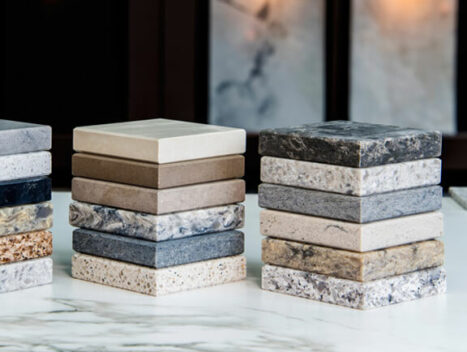Ask our Experts ?
How do I maintain my granite?
Soap and water! We will provide you with detailed instructions but the bottom line is just soap and water. Granite is sealed before cutting to help prevent staining. You should re-seal your granite once a year thereafter. Oil spills can be problematic so, if you spill oil on your counters, clean it up as you go and do not allow it to sit on the stone for any length of time. We also recommend that at least once a month you wipe down your counter tops with Pledge. This just helps add extra protective coating and shine.
How careful do I have to be with granite?
Granite is scratch resistant and heat resistant. You can take your pots right off the stove and place them on the granite and take things right out of the oven and place them on the granite. Do not cut on the granite because you run the risk of dulling your knives! Other stones such as marble and limestone do not perform as well and we discourage their use in several places, especially the kitchen.
Can I cut on granite?
Sure if you want to dull your knife. You will not harm the granite. Marble on the other hand is a more porous material and therefore much more likely to be damaged by a sharp object.
Can I set hot pans on my granite?
The darker the material the more dense and therefore the more heat it will hold. The biggest issue with putting a hot pan on granite is that if you touched the spot it could be as hot as the pan itself and therefore cause you an injury. You should be especially cautious with black granite since it is the most dense and with repeat exposure may actually crack.
Why choose Granite for a countertop?
At the top of the list is its exquisite natural beauty. With the ability to choose from variety of granite colors you are assured your countertop will be unique unto itself. Granite is, by far, the most durable of all surfaces used in counter top construction.
What’s the difference between marble and granite?
Although both are stones and both are quarried from the earth, granite and marble (and marble’s relatives – limestone, onyx and travertine) are very different from each other. Granite is formed deep in the earth’s mantle at extremely high temperatures, and is a very hard, resistant stone made of crystallized minerals. The marble family – limestone, travertine, marble, and onyx – starts out as sediment – animal skeletons and shells, plant matter, silt – at the bottom of bodies of water. After millions of years this solidifies into stone. Because its main component is calcium, acids such as vinegar and citrus beverages can affect it.
Is it necessary to seal stone?
All stone, even granite, is porous to some degree, and will absorb moisture over time. Some stones are more porous than others, so it is important to use a penetrating sealer to prevent stains from oil, wine, or other liquids from soaking into the surface.
Why is granite good for kitchen counters?
Granite adds elegance and style to kitchens, baths and other areas of the home with a richness that cannot be duplicated in synthetic materials. Granite is highly resistant to scratching, cracking and staining. Impervious to heat: daily kitchen activities pose no problem and it can take a hot pot without the use of a trivet. Thus, making granite an ideal choice for counter tops.
Can granite crack?
Not with ordinary use. Granite is most susceptible to cracks during shipping and installation. Normal use will not over-stress this durable material. Normal use does not include standing on the counter tops 🙂
Can you scratch granite?
Granite is one of the hardest stones in the world. It is highly resistant to scratching in ordinary use. A knife blade will not scratch granite. It can only be scratched by another piece of granite or with specially sharpened tools designed to work with granite like tungsten and diamond blades.
Does granite burn?
No. You can’t burn granite with ordinary use. It is perfectly okay to set hot pots or pans directly from the stove or oven onto granite.
Does Granite stain?
In general, no. All stone, however, is porous to some extent, but Granite has very little porosity. A few colors may absorb some moisture with prolonged contact compared to others. For example, a puddle of water left on the counter, for some colors, may show a dark spot when the water is wiped away. Usually, no evidence remains once the liquid is removed and the granite dries. A stone sealer is highly recommended for all granite after installation.
Will my granite look like the sample?
The samples you see on the computer may not be absolutely correct due to variations in computer systems, monitors and software compression. Marble and granite are natural stones created by the forces of nature. They are composed of various minerals and are susceptible to wide variations in color, texture, spotting, veining and cracking. These variations are expected and are the source of its natural beauty.
Will my kitchen have seams?
Due to the limitation of slab size, seams on a granite countertop are necessary and sometimes unavoidable. A good place to incorporate seams is near sinks or cook tops. This will help to cover most of the seam-leaving a minimum amount in view. You may also want to consider putting seams where cabinets change direction or using forty-five or ninety-degree angles. This application often works well because the human eye has to adjust to the change in direction making the seam less noticeable. The visibility of seams will depend on the granularity, color and pattern. But relax, most seams are close to unnoticeable to the human eye.
Do granite countertops overhang the cabinets?
Most counters overhang by 1 1/2″, which is standard. This may be changed for whatever reason due to cabinet configuration, cabinet installation, and/or personal tastes.
Can granite cantilever?
You can cantilever granite up to 12″ with sufficient support on the fixed end and with a large enough piece. Never cantilever unsupported granite where it might receive excessive stress like someone sitting on a counter or stepping on a counter to change a light bulb. You must have support underneath for these situations.
Does Granite Harbor Bacteria?
Granite continues to be used and approved in food and medical applications. The CDC (Centers for Disease Control and Prevention) has no records of granite harboring bacteria, and has no reports of people becoming ill from bacteria in granite. With regular cleaning, granite is far less likely to support bacteria than butcher block or even laminated materials with top-mounted sinks.
I’ve noticed some granite's have pits on the surface - will I have these on my kitchen counters?
Granite, which is crystalline in structure, always has tiny pits – spaces between the various mineral crystals. Granite sometimes has natural fissures as well, which may look like cracks, but are not structural defects and are a naturally occurring result of the immense heat and pressure that formed the granite eons ago. These characteristics are part of the natural beauty of stone and will not impair the function or durability of the material. A product of nature cannot be expected to look man made.
Why choose granite counter tops over synthetic materials?
Granite has become today’s countertop of choice for architects, cabinetmakers, kitchen designers and contractors. A granite counter top is virtually impervious to abrasions, stains and extreme heat. Additionally, the inherented qualities of granite — its color, patterns and shades — compliment any décor.
My granite kitchen counter top doesn’t look exactly like my sample. Why?
Granite is an organic substance and just as no two people are exactly alike, no two samples of granite will be either. The composition of minerals and the deposit it was quarried from all play a part in the appearance of granite.
Are all granite kitchen counters a high gloss finish?
No, there are several different finishes you can order; the highly polished finish is just the most popular. There is a process called “honing” that gives the stone a more matte finish yet retains its smooth feel.
What’s the difference between a drop-in sink and an under-mount sink?
A drop-in sink sits on top of the cutout in your granite counter while an under-mount sink sits beneath the cutout. There is generally an extra polishing charge required in preparing a granite countertop for an under-mount sink.
I’ve heard of "high movement" stone. What is it?
Sometimes called “grain in the stone,” “movement” is veins that swirl and change irregularly in granite due to the massive forces at work on it beneath the surface of the earth during the eons it took to form.
Will I know where my granite is from?
Probably not since granite is quarried all over the world, including Africa, Brazil, Egypt, India, Italy, Norway and Spain, to name a few. There are also some very lovely veins of granite mined in the United States and Canada as well.
Does where my granite originate from affect the price?
Very little. Prices are more affected by the supply and demand placed upon the quarry. You’ll find that red and blue tones are a bit higher priced than other colors due to their lack of abundance.
Are Granite Counter Tops Expensive?
Improved stone-working technology has made granite countertops very affordable compared with man-made hard surface materials. With granite, the resale value of your property will also grow with time.





